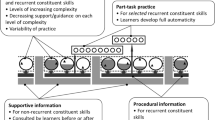Abstract
Cognitive load theory (Sweller, Ayres, & Kalyuga, 2011) is an instructional theory based on some aspects of human cognition. It takes an evolutionary approach to cognition. The theory assumes two categories of knowledge: biologically primary and biologically secondary knowledge. Primary knowledge is knowledge we have evolved to acquire over many generations. Secondary knowledge is cultural knowledge that humans have required more recently and have not specifically evolved to acquire. Cognitive load theory applies to secondary rather than primary knowledge. With respect to secondary knowledge, the theory assumes that human cognition constitutes a natural information processing system that has evolved to mimic another natural information processing system, biological evolution, with both systems characterised by the same basic principles. These principles lead directly to the assumption that biologically secondary knowledge consists of a very large range of domain-specific knowledge structures and that the primary aim of instruction is to assist learners in the acquisition of that knowledge. There are two basic structures associated with human cognitive architecture that are critical to instructional design – working memory and long-term memory.
Cognitive load theory assumes a limited working memory used to process novel information and a large, long-term memory used to store knowledge that has been acquired for subsequent use. The purpose of instruction is to store information in long-term memory. That information consists of everything that has been learned, from isolated, rote-learned facts to complex, fully understood concepts and procedures. Learning is defined as a positive change in long-term memory. If nothing has changed in long-term memory, nothing has been learned.
The theory has been used to generate a wide range of instructional procedures. Each of the procedures is designed to reduce extraneous working memory load in order to facilitate the acquisition of knowledge in long-term memory. One such procedure is based on the transient information effect, an effect that is closely associated with the use of instructional technology to present information.
When technology is used to present information to learners, the modality and format of the presentation is frequently changed. For example, written information may be substituted by spoken information and the static graphics associated with hard copy may be replaced by animations. While instructional designers are usually highly cognizant of these changes, there is another, concomitant but less obvious change that occurs. Relatively transient forms of information such as speech or animations replace a relatively permanent form of information such as written text or visual graphics. Frequently, this change is treated as being incidental and is ignored. Cognitive load theory suggests that it may be critical. Limited human working memory results in transient, technology-based information having considerable instructional consequences, many of them negative. Theory and data associated with the transient information effect will be discussed in relation to e-learning.
Access this chapter
Tax calculation will be finalised at checkout
Purchases are for personal use only
Similar content being viewed by others
References
Sweller, J., Ayres, P., Kalyuga, S.: Cognitive load theory. Springer, New York (2011)
Author information
Authors and Affiliations
Editor information
Editors and Affiliations
Rights and permissions
Copyright information
© 2011 Springer-Verlag Berlin Heidelberg
About this paper
Cite this paper
Sweller, J. (2011). Cognitive Load Theory and E-Learning. In: Biswas, G., Bull, S., Kay, J., Mitrovic, A. (eds) Artificial Intelligence in Education. AIED 2011. Lecture Notes in Computer Science(), vol 6738. Springer, Berlin, Heidelberg. https://doi.org/10.1007/978-3-642-21869-9_3
Download citation
DOI: https://doi.org/10.1007/978-3-642-21869-9_3
Publisher Name: Springer, Berlin, Heidelberg
Print ISBN: 978-3-642-21868-2
Online ISBN: 978-3-642-21869-9
eBook Packages: Computer ScienceComputer Science (R0)




